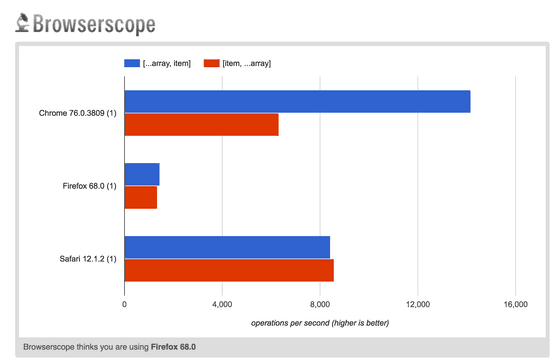In this post, you will read an interesting investigation on how to boost the performance of the spread operator.
Let's start with a short introduction on how spread operator works inside array literals.
The spread operator, or three dots, takes an array or generally an iterable [...arrayOrIterable] and slices it into pieces. Then the array literal uses these pieces to construct a new array.
The spread operator can be placed at any position inside the array literal:
const numbers = [1, 2, 3];[0, ...numbers]; // => [0, 1, 2, 3][0, ...numbers, 4]; // => [0, 1, 2, 3, 4][...numbers, 4]; // => [1, 2, 3, 4]
Now comes the interesting question. Is there a position of the spread operator inside the array literal that could increase performance? Let's find out.
1. Append to head and to tail functions
Before starting the performance comparisons, let's define two functions.
The first one is appendToTail():
function appendToTail(item, array) { return [...array, item];}const numbers = [1, 2, 3];appendToTail(10, numbers); // => [1, 2, 3, 10]
appendToTail() inserts the item at the end of the array. This function uses [...array, item].
The second one is appendToHead():
function appendToHead(item, array) { return [item, ...array];}const numbers = [1, 2, 3];appendToHead(10, numbers); // => [10, 1, 2, 3]
appendToHead() is a pure function that returns a new array where the item is appended at the head of the original array. It uses [item, ...array].
At first sight, there's no reason to think that these functions perform differently. But let's take a try.
2. The performance test
Let's run the performance test of [...array, item] vs [item, ...array] on a MacBook Pro laptop in the following 3 browsers:
- Chrome 76
- Firefox 68
- Safari 12.1
Here are the performance test results:

As expected, in Firefox and Safari browsers [...array, item] and [item, ...array] have the same performance.
In Chrome, however, [...array, item] performs twice faster than [item, ...array]. That's a useful result.
To accelerate the performance of spread operator in Chrome, use the spread operator at the beginning of the array literal:
const result = [...array, item];
But another question arises: why does it happen?
3. The fast-path optimization
Starting the version 7.2 of the V8 engine (that powers the JavaScript execution in Chrome) a new optimization of the spread operator is available: the fast-path optimization.
In a few sentences, it works as follows.
Without this optimization, when the engine encounters a spread operator [...iterable, item], it invokes the iterator (iterator.next()) of the iterable object. On each iteration, the memory of the resulted array is increased, and the iteration result is added to it.
But the fast-path optimization detects a known iterable (like an array of integers) and skips the creation of the iterator object at all. Then the engine reads the length of the spread array, allocating only once memory for the resulted array. Then passes by index the spread array, adding each item to the resulted array.
The fast-path optimization skips the creation of the iteration object, allocating the memory for the result only once. Thus the performance increase.
4. Supported data structures
The fast-path optimization applies to the following standard JavaScript data structures.
Arrays
const numbers = [1, 2, 3, 4];[...numbers, 5]; // => [1, 2, 3, 4, 5]
Strings
const message = 'Hi';[...message, '!']; // => ['H', 'i', '!']
Sets
const colors = new Set(['blue', 'white']);[...colors, 'green']; // => ['blue', 'white', 'green'][...colors.values(), 'green']; // => ['blue', 'white', 'green'][...colors.keys(), 'green']; // => ['blue', 'white', 'green']
Maps
On maps only map.keys() and map.values() methods are supported:
const names = new Map([[5, 'five'], [7, 'seven']]);[...names.values(), 'ten']; // => ['five', 'seven', 'ten'][...names.keys(), 10]; // => [5, 7, 10]
5. Conclusion
When the spread array is located at the beginning of the array literal, you can get a performance boost due to the fast-path optimization. It is available in V8 engine v7.2 (shipped in Chrome v72 and NodeJS v12).
With this optimization, the performance test shows that [...array, item] can perform at least twice faster than [item, ...array].
Note that while fast-path is indeed useful, you might want to use it in places where the performance is important, or if you'll dealing with large arrays.
Otherwise, in most situations, don't force the optimization since the end-user most likely will not feel the difference.
What interesting performance optimizations in JavaScript do you know?


